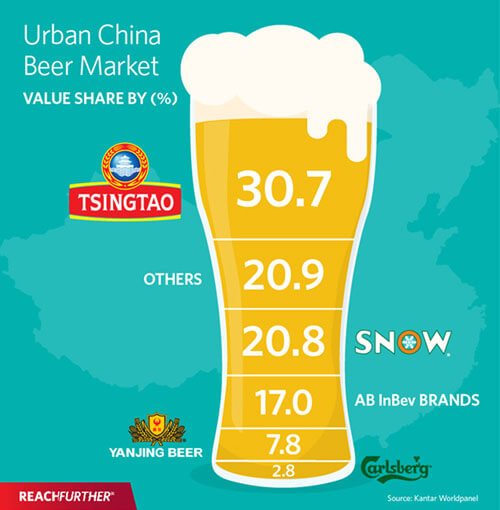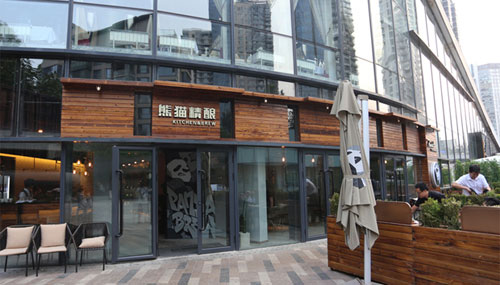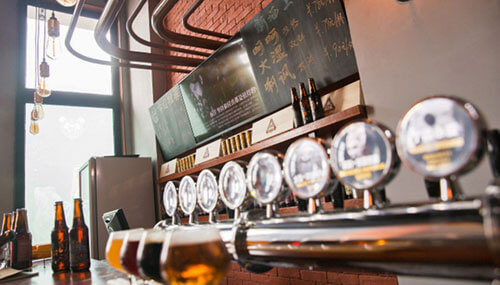U.S.-Asia Business
Opportunities are Brewing in China’s Craft Beer Industry
By

China is the world’s largest beer market, and its taste for premium beers is growing.
Steven Zhang, a young professional living in Shanghai, China, is no stranger to beer: Like many people in China and abroad, he likes to grab the occasional beer after work with his friends—but not just any old Tsingtao or Yanjing Beer, two of China’s biggest beer producers. In fact, when going out, he makes a conscious effort to pick out places with a quality beer selection and cites that as “the most important reason” for choosing a bar or restaurant.
“The taste between craft beer and mass-produced is totally different,” says Zhang. “Craft beer is fresh—this is the most important element for most drinkers. It tastes very fresh, versus mass-produced one, which doesn't.”
China has always been a huge consumer of beer (it is the world’s largest consumer and producer of beer), but tastes have been shifting away from “macro” beers (i.e. beers produced en masse, such as Budweiser) to more premium and craft flavors. Sales volumes of cheaper Chinese beers have been falling—both Tsingtao and Yanjing posted losses in sales in 2016. However, demand for high-end beers is growing, and China’s market is ripe with opportunities for both domestic and foreign craft brewers.
China’s craft beer market
It was 2008 when Dinghao Pan, founder of Beijing-based craft brewery Panda Brew, first came across the concept of craft beer while studying abroad in Canada. “I saw a trend for craft beer happening in North America,” he shares. “When I came back to China, I found that there was almost no craft beer here, so I thought, ‘Well, maybe I can introduce this tasty beer to the Chinese market.’”
It’s a gamble that’s paying off: China’s craft beer culture can thank millennials and a growing middle class for its rise. According to McKinsey & Company, Chinese consumers are maturing and more willing to spend more on premier products, such as alcohol. Although the overall volume has decreased, the overall value of Chinese beer sales has actually risen slightly. Reports also show that Chinese millennial consumers are increasingly attracted to premium products and services, and are more and more likely to buy from local brands.

“People want to spend the same amount of money but try something different—different flavors, different [brewing] methods, something that is better quality,” says Pan, on China’s nascent craft beer market. “That’s the most important thing—people want to try something good, or better, for the same cost.”
Crafting opportunities in China
Although China only comprises 2.5 percent of American craft beer exports in 2017 and has a burgeoning domestic craft beer industry, China—and the Asia-Pacific region, in general—is one of the fastest growing regions for American craft beer, says Steve Parr, the Export Development Program manager at the Brewers Association, an American nonprofit trade organization that supports small and independent brewers. According to the Financial Times, 40 percent of all beer consumed in China was imported, which means that there is substantial room for growth for American brewers, particularly in the premium alcohol segment. Even Anheuser-Busch InBev (AB InBev), the maker of America’s top-selling beer Budweiser, has aggressively been expanding into China to capitalize on the market: The company purchased a stake in popular Shanghai-based craft brewer, Boxing Cat, which introduced Chicago-based Goose Island (which AB InBev bought in 2011) into China, and plans to launch a Goose Island brewery in the country.
China’s craft beer culture is still young and has primarily been driven by foreigners living and working abroad, which makes them the perfect target demographic for craft brewers first entering the Chinese market, says Parr. “It’s a small population that’s familiar with craft beer, so far,” he explains. “The young people, sure, but it’s primarily been expats [expatriates] that seek out craft beer in China and are introducing it to friends.” However, Parr adds that craft beer is becoming increasingly popular among locals, particularly the worldly younger generations who seek out “trendy and high-quality” products.
Many expats are also purveyors of some of China’s first and most well-known craft breweries. “The major percentage of craft brewers are around 30-40 years old, the younger generations who are studying and learning anything from outside and trying to introduce this interesting culture to China,” Pan explains, on the reasons behind China’s craft beer boom. “Also, some foreigners are trying to start up their own business in China—Great Leap, Jing A [two popular Chinese craft breweries], are all owned by Americans.”
Despite the seeming influx of foreign and domestic brewers, Pan believes that competition is still relatively low. “Ninety percent of consumers are still drinking industrial beer,” he says. “They don’t know what craft beer is and haven’t tried it before. I think educating them [on craft beer] is the hardest thing so far.”
"I had to educate every single person, including my employees, on what craft beer is...It’s like building everything from scratch—it’s pretty hard."

Appealing to Chinese taste buds
Panda Brew’s most popular beer is the Red Honey Ale, which is infused with a special type of honey from China and is “quite sweet,” with a “strong honey aroma.”
“Chinese people are still trying to switch from industrial lagers to craft beers,” says Pan. “[They need] an introductory type of craft beer, like a Belgian wheat, or something sweet and easy to drink.”
Parr agrees. “For drinkers that are not as familiar with the bitter beers [like IPAs], we see a preference for slightly fruitier, sweeter beers, like wheat beers and hefeweizens,” he explains. “I think it’s an easier transition, especially for a country of consumers that’s used to drinking these beers that are much lower in alcohol and have a whole lot less flavor. We see that here in the United States, too, where there’s these lighter, more approachable styles that serve as opportunities to introduce beer drinkers to something that’s a little more flavorful. Once they develop their palates, they start to drink IPAs, sours, and barrel-aged beers—but you don’t jump into those right away.”
Although flavor is perhaps the most important part of craft beer, Parr says not to discount the effects of packaging to appeal to Chinese consumers. “American craft brewers have these creative and illustrative designs that stand out on store shelves,” he points out. “That’s something that catches their eyes, so they choose a beer based off of the packaging and how it looks.”
Challenges of the Chinese market
Because craft beer is relatively new and concentrated among expats, not many people outside of Tier 1 cities like Shanghai and Beijing understand what it is, although the trend is starting to spread. Pan makes an effort to educate people about the nuances of craft beer so that they can fully appreciate the differences from mass-produced beer. He and Panda Brew attend festivals where he thinks his target demographic will go, and serves tasting flights at Panda Brew pub locations so that customers can learn more about the different flavors, styles, and types of beer. “I had to educate every single person, including my employees, on what craft beer is, what it tastes like, what are the types of differences, and also what the culture is like,” says Pan. “It’s like building everything from scratch—it’s pretty hard.”
There are also logistical challenges to consider when exporting to China, adds Parr. Craft beer is best served as fresh as possible to get the full impact of the flavor, which means that overseas brewers trying to export to China have to contend with the additional costs of shipping long distances, as well as the extended shipping time and lack of proper storage facilities.
“That’s an immediate challenge that’s tough to overcome,” admits Parr, “but China has seen improvements in storage and handling over the years, so a growing number of importers are investing in upgraded infrastructure that maintains cold-chain throughout the beer’s life cycle: being kept cold from when it leaves the brewery, to when it gets to the customers’ hands. The beer tastes better, and that’s good for everybody, both the brewery and the retailers that are selling that product.” These areas also serve as excellent alternative opportunities for people looking to enter China’s craft beer market without opening their own brewery, adds Pan.

“Once they develop their palates, they start to drink IPAs, sours, and barrel-aged beers—but you don’t jump into those right away.”
Like Panda Brew, Parr and the Brewers Association (BA) also utilize festivals and conferences to educate trade members on best practices, as well as to develop the right connections for members of their association. Parr says that the Brewers Association recently participated in the Beijing Invitational Craft Beer Festival, where 18 members of BA’s Export Development Program presented their beers to attending consumers, media and trade members.
“Brewers that made the trip were able to meet the importers and learn about the markets,” Parr shares. “We also conducted a media event at a craft beer bar in Shanghai following the festival that consisted of a guided tasting, and [talked about] quality and best practices for craft beer to the Chinese members of trade and media.”
The future of craft beer in China
As consumer tastes mature and become more diverse, so will the number of local breweries that operate in China. However, instead of seeing the increased competition as a negative, Parr views it as a boon for American craft brewers and the industry overall.
“When the local Chinese market is establishing its own small beer producers, that’s going to expose local consumers to the concept of better beer,” he explains. “If more people get exposed to the idea, it’s going to invite them to explore new products. So, as local craft beer becomes adopted by local consumers, there will be more options and opportunities to taste American craft beer—or create that desire to experiment. Just the idea of consuming something that’s a local, quality product is going to open people up to the idea of trying beers also made from afar.”
Pan concurs: “This is a very new industry. We need to get help from anywhere we can get, but also we need to work very hard with each other—all the craft beer brands have to stick together.”

